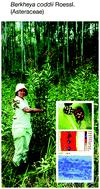当前位置:
X-MOL 学术
›
Metallomics
›
论文详情
Our official English website, www.x-mol.net, welcomes your
feedback! (Note: you will need to create a separate account there.)
Ecophysiology of nickel hyperaccumulating plants from South Africa - from ultramafic soil and mycorrhiza to plants and insects.
Metallomics ( IF 2.9 ) Pub Date : 2020-05-27 , DOI: 10.1039/c9mt00282k Jolanta Mesjasz-Przybyłowicz 1 , Wojciech J Przybyłowicz
Metallomics ( IF 2.9 ) Pub Date : 2020-05-27 , DOI: 10.1039/c9mt00282k Jolanta Mesjasz-Przybyłowicz 1 , Wojciech J Przybyłowicz
Affiliation

|
An overview of 30 years of studies related to South African nickel hyperaccumulators is presented. Only five species have so far been identified as Ni hyperaccumulator plants among very rich and diversified South African flora. All of them occur on soils derived from ultramafic (serpentine) rocks and belong to the family Asteraceae: Berkheya coddii Roessler, Berkheya zeyheri subsp. rehmannii var. rogersiana, Berkheya nivea, Senecio coronatus, Senecio anomalochrous. Several techniques and methods were used to investigate ecophysiological aspects of the Ni hyperaccumulation phenomenon, from basic field and laboratory studies, to advanced instrumental methods. Analysis of elemental distribution in plant parts showed that in most cases the hyperaccumulated metal was stored in physiologically inactive tissues such as the foliar epidermis. However, an exception is Berkheya coddii, which has a distinctly different pattern of Ni distribution in leaves, with the highest concentration in the mesophyll. Such a distribution suggests that different physiological mechanisms are involved in the Ni transport, storage location and detoxification, compared to other hyperaccumulator species. Berkheya coddii is a plant with high potential for phytoremediation and phytomining due to its large biomass and potentially high Ni yield, that can reach 7.6% of Ni in dry mass of leaves. Senecio coronatus is the only known hyperaccumulator with two genotypes, hyperaccumulating and non-hyperaccumulating, growing on Ni-enriched/metalliferous soil. Detailed ultrastructural studies were undertaken to characterize specialized groups of cells in the root cortex of Ni-hyperaccumulating genotype, that are not known from any other hyperaccumulator. The occurrence of arbuscular mycorrhiza (AM) in Ni-hyperaccumulating plants was found for the first time in South African hyperaccumulator plants, and this type of symbiosis has been proved obligatory in all of them. There is a significant influence of mycorrhiza on the concentration and distribution of several elements. Three highly specialized herbivore insects feeding only on Ni hyperaccumulator plants were identified: Chrysolina clathrata (formerly Chrysolina pardalina), Epilachna nylanderi and Stenoscepa sp. The Ni-elimination strategies of these specialised insects have been established. Microbiological studies have revealed several genera of fungi and bacteria isolated from B. coddii leaves as well as presence of specialised, Ni-resistant yeasts in the C. clathrata gut. Understanding ecophysiological response to harsh environment broadens our knowledge and can have practical applications in cleaning polluted environments through phytomining/agromining. Finally, conservation aspects are also discussed and lines for future research are proposed.
中文翻译:

南非镍超富集植物的生态生理学——从超镁铁质土壤和菌根到植物和昆虫。
概述了 30 年来与南非镍超富集器相关的研究。迄今为止,在非常丰富和多样化的南非植物群中,只有五个物种被确定为镍超富集植物。它们都发生在源自超镁铁质(蛇纹石)岩石的土壤上,属于菊科:Berkheya coddii Roessler、Berkheya zeyheri subsp。地黄变种 rogersiana , Berkheya nivea , Senecio coronatus , Senecio anomalochrous. 从基础的实地和实验室研究到先进的仪器方法,使用了多种技术和方法来研究镍超积累现象的生态生理学方面。对植物部分元素分布的分析表明,在大多数情况下,超积累的金属储存在生理上不活跃的组织中,例如叶表皮。然而,Berkheya coddii是一个例外,它在叶子中具有明显不同的 Ni 分布模式,在叶肉中的浓度最高。这种分布表明,与其他超富集物种相比,镍的运输、储存位置和解毒涉及不同的生理机制。鳕鱼由于其生物量大和潜在的高镍产量,在植物修复和植物挖掘方面具有很高的潜力,在叶子干质量中可以达到 7.6% 的镍。千里光是唯一已知的具有两种基因型的超积累植物,超积累和非超积累,生长在富镍/金属土壤上。进行了详细的超微结构研究,以表征 Ni 超积累基因型根皮层中的特定细胞群,这些细胞在任何其他超积累基因中都不知道。在南非超富集植物中首次发现了丛枝菌根(AM)在镍超富集植物中的存在,并且这种共生已被证明在所有植物中都是必需的。菌根对几种元素的浓度和分布有显着影响。鉴定了三种仅以 Ni 超富集植物为食的高度特化的食草昆虫:Chrysolina clathrata(以前称为Chrysolina clathrata)Chrysolina pardalina )、Epilachna nylanderi和Stenoscepa sp。这些专门昆虫的镍消除策略已经建立。微生物研究揭示了从B. coddii叶子中分离出的几种真菌和细菌属,以及C. clathrata肠道中存在专门的抗镍酵母菌。了解对恶劣环境的生态生理反应可以拓宽我们的知识面,并且可以通过植物挖掘/农艺挖掘在清洁污染环境方面具有实际应用。最后,还讨论了保护方面,并提出了未来研究的路线。
更新日期:2020-07-22
中文翻译:

南非镍超富集植物的生态生理学——从超镁铁质土壤和菌根到植物和昆虫。
概述了 30 年来与南非镍超富集器相关的研究。迄今为止,在非常丰富和多样化的南非植物群中,只有五个物种被确定为镍超富集植物。它们都发生在源自超镁铁质(蛇纹石)岩石的土壤上,属于菊科:Berkheya coddii Roessler、Berkheya zeyheri subsp。地黄变种 rogersiana , Berkheya nivea , Senecio coronatus , Senecio anomalochrous. 从基础的实地和实验室研究到先进的仪器方法,使用了多种技术和方法来研究镍超积累现象的生态生理学方面。对植物部分元素分布的分析表明,在大多数情况下,超积累的金属储存在生理上不活跃的组织中,例如叶表皮。然而,Berkheya coddii是一个例外,它在叶子中具有明显不同的 Ni 分布模式,在叶肉中的浓度最高。这种分布表明,与其他超富集物种相比,镍的运输、储存位置和解毒涉及不同的生理机制。鳕鱼由于其生物量大和潜在的高镍产量,在植物修复和植物挖掘方面具有很高的潜力,在叶子干质量中可以达到 7.6% 的镍。千里光是唯一已知的具有两种基因型的超积累植物,超积累和非超积累,生长在富镍/金属土壤上。进行了详细的超微结构研究,以表征 Ni 超积累基因型根皮层中的特定细胞群,这些细胞在任何其他超积累基因中都不知道。在南非超富集植物中首次发现了丛枝菌根(AM)在镍超富集植物中的存在,并且这种共生已被证明在所有植物中都是必需的。菌根对几种元素的浓度和分布有显着影响。鉴定了三种仅以 Ni 超富集植物为食的高度特化的食草昆虫:Chrysolina clathrata(以前称为Chrysolina clathrata)Chrysolina pardalina )、Epilachna nylanderi和Stenoscepa sp。这些专门昆虫的镍消除策略已经建立。微生物研究揭示了从B. coddii叶子中分离出的几种真菌和细菌属,以及C. clathrata肠道中存在专门的抗镍酵母菌。了解对恶劣环境的生态生理反应可以拓宽我们的知识面,并且可以通过植物挖掘/农艺挖掘在清洁污染环境方面具有实际应用。最后,还讨论了保护方面,并提出了未来研究的路线。











































 京公网安备 11010802027423号
京公网安备 11010802027423号